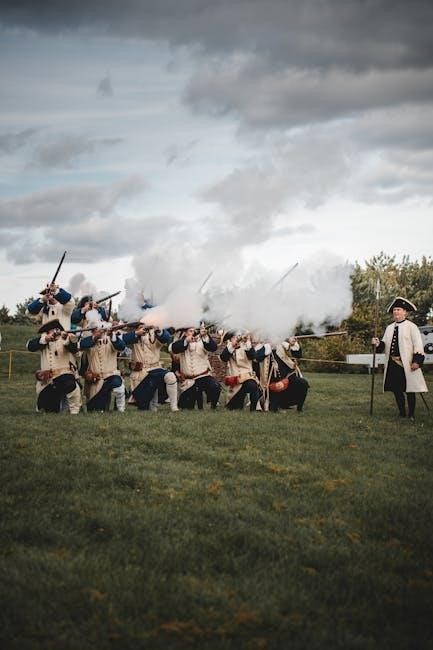Overview of “O Captain! My Captain!”
Walt Whitman’s “O Captain! My Captain!” is an elegy. It mourns the death of a captain after a successful voyage. The poem uses extended metaphor. It reflects themes of the American Dream. It honors Abraham Lincoln.

Historical Context: Abraham Lincoln’s Assassination
Published in November 1865, approximately seven months following Abraham Lincoln’s assassination, Walt Whitman’s “O Captain! My Captain!” is deeply rooted in the historical context of the United States during that tumultuous period. The nation, already war-torn and weary from the Civil War, was plunged into mourning upon Lincoln’s death. Whitman, having witnessed the war’s impact and admired Lincoln, crafted the poem as a tribute to the fallen president and a reflection on the nation’s grief.
Lincoln’s assassination on April 14, 1865, just days after the end of the Civil War, marked a pivotal moment in American history. His leadership had guided the Union through the war, and his death left a void in the nation’s collective psyche. Whitman’s poem captures the raw emotions of that time, expressing the sense of loss and uncertainty that permeated the country. The poem serves as a historical document, providing insight into the national sentiment following Lincoln’s assassination and the profound impact it had on American society. The elegy not only mourns the death of a leader but also symbolizes the end of an era and the challenges of Reconstruction that lay ahead. It reflects the challenges to popular government raised during the Civil War and how Lincoln answered them, immortalizing his legacy in verse. The poem stands as a testament to Lincoln’s enduring influence and the nation’s struggle to come to terms with his untimely death.

Symbolism and Metaphor in the Poem
“O Captain! My Captain!” employs extensive symbolism. The captain symbolizes Abraham Lincoln. The ship represents the United States. The “fearful trip” mirrors the Civil War. The poem captures the nation’s mood after Lincoln’s assassination.
The Ship as a Metaphor for the United States
In Walt Whitman’s “O Captain! My Captain!”, the ship serves as a central and powerful metaphor for the United States of America. This extended metaphor allows Whitman to explore the complex emotions surrounding the nation’s state following the Civil War and the death of President Abraham Lincoln. The ship, having “weathered every rack,” symbolizes the resilience and endurance of the United States through the trials and tribulations of the war. Just as a ship navigates through turbulent waters, the nation has persevered through a “fearful trip,” overcoming immense challenges and ultimately achieving victory.
The journey of the ship mirrors the historical journey of the United States during the Civil War era. The “prize we sought is won” signifies the preservation of the Union and the end of slavery. The ship’s arrival in port, with “bells I hear, the people all exulting,” reflects the jubilation and celebration that swept the nation after the Union’s victory. However, this joyous arrival is juxtaposed with the tragic reality of the fallen captain, highlighting the bittersweet nature of the moment.
The “steady keel” and “vessel grim and daring” emphasize the strength and determination of the United States in the face of adversity. Despite the immense loss and suffering, the nation remained steadfast in its commitment to its ideals and its pursuit of a more perfect union. The ship, therefore, becomes a symbol of American resolve and its capacity to overcome even the most daunting obstacles.
Whitman’s choice of the ship as a metaphor is particularly apt, given the historical context of the poem. In the 19th century, ships were vital for trade, transportation, and exploration, representing progress, connectivity, and the expansion of horizons. By employing this symbol, Whitman connects the fate of the United States to the universal human experience of navigating the unpredictable seas of life. The ship, in its triumph and tragedy, embodies the hopes, dreams, and sacrifices of a nation striving to achieve its destiny.
The Captain as Abraham Lincoln
In Walt Whitman’s poignant elegy, “O Captain! My Captain!”, the captain of the ship is a powerful and unmistakable symbol for President Abraham Lincoln. This metaphorical representation allows Whitman to explore the profound grief and sense of loss that gripped the nation following Lincoln’s assassination, just as the Civil War reached its conclusion. The captain, having guided the ship through a “fearful trip,” embodies Lincoln’s leadership during the tumultuous years of the Civil War. Just as a captain is responsible for the safety and direction of his ship, Lincoln steered the United States through the storm of secession and conflict, ultimately leading the Union to victory.
The line “O Captain! my Captain! our fearful trip is done” acknowledges the successful completion of the arduous journey, mirroring Lincoln’s achievement in preserving the Union. However, the subsequent lines, “Where on the deck my Captain lies, Fallen cold and dead,” reveal the tragic reality of Lincoln’s death, casting a pall over the celebratory atmosphere. The captain’s death symbolizes the loss of Lincoln’s guiding hand, leaving the nation bereft of its leader during a critical period of reconstruction.
The poem emphasizes the deep personal connection between the speaker and the captain, reflecting the widespread admiration and affection that many Americans felt for Lincoln. The speaker’s lament, “But O heart! heart! heart! O the bleeding drops of red,” conveys the intense pain and sorrow that accompanied Lincoln’s assassination. The image of the captain lying dead on the deck evokes a sense of vulnerability and loss, highlighting the fragility of even the most powerful leaders.
Whitman’s choice of the captain as a symbol for Lincoln is particularly fitting, given Lincoln’s role as the commander-in-chief of the Union Army and Navy during the Civil War. The captain embodies the qualities of leadership, courage, and determination that Lincoln exemplified throughout his presidency. By immortalizing Lincoln as the fallen captain, Whitman ensures that his legacy as a leader and savior of the Union will endure.
The “Fearful Trip” as the Civil War
In Walt Whitman’s “O Captain! My Captain!”, the “fearful trip” serves as a potent and evocative metaphor for the American Civil War. This extended metaphor allows Whitman to explore the immense challenges, sacrifices, and ultimate triumph associated with this pivotal period in American history. The “fearful trip” represents the arduous and perilous journey the nation undertook during the war, fraught with division, bloodshed, and uncertainty.
The poem’s opening lines, “O Captain! my Captain! our fearful trip is done, The ship has weather’d every rack, the prize we sought is won,” acknowledge the successful completion of this tumultuous journey. The “prize” symbolizes the preservation of the Union, the primary objective of the North during the Civil War. However, the poem quickly transitions from celebration to mourning, as the captain, representing Abraham Lincoln, lies dead on the deck. This juxtaposition highlights the bittersweet nature of the Union victory, achieved at the cost of immense human suffering and the loss of the nation’s leader.
The “fearful trip” metaphor encompasses the various hardships and trials endured during the Civil War, including battles, political strife, and social upheaval. The “ship” represents the United States, navigating through treacherous waters and facing formidable storms. The “rack” symbolizes the various challenges and obstacles encountered during the war, such as secession, military defeats, and internal dissent.
Whitman’s use of the “fearful trip” metaphor effectively conveys the emotional toll of the Civil War on the American people. The poem captures the sense of relief and jubilation that followed the Union victory, but also acknowledges the deep sense of loss and grief that permeated the nation in the wake of Lincoln’s assassination. The “fearful trip” serves as a reminder of the sacrifices made to preserve the Union and the enduring impact of the Civil War on American identity.
Structure and Form: An Elegy
“O Captain! My Captain!” is structured as an elegy. Elegies are mourning poems. Whitman wrote it after Lincoln’s death. It has 3 stanzas. Each stanza has 8 lines. The poem uses free verse. It’s a tribute to a fallen leader after a difficult journey.
Stanza Structure and Rhyme Scheme (ABAB, CDCD, EFEF)
Walt Whitman’s “O Captain! My Captain!” comprises three stanzas, each containing eight lines, forming a total of twenty-four lines. The poem adheres to a consistent rhyme scheme throughout, following the pattern of ABAB, CDCD, and EFEF. This structure contributes to the poem’s musicality and helps to emphasize key themes. The use of quatrains within each stanza further enhances the poem’s organization, creating distinct units of thought and emotion. Each quatrain presents a different facet of the speaker’s grief and admiration for the fallen captain, while the rhyme scheme provides a sense of unity and coherence. The regular structure and rhyme scheme contrast with the free verse form that Whitman often employed, highlighting the formal nature of the elegy and the solemnity of the occasion. The poem’s structured form serves to elevate the emotional impact of the speaker’s lament, creating a powerful and memorable tribute to the deceased leader. The ABAB rhyme scheme in the first stanza introduces the central themes of the poem: the successful completion of the voyage and the tragic death of the captain. The CDCD rhyme scheme in the second stanza deepens the sense of mourning and explores the emotional turmoil of the speaker. The EFEF rhyme scheme in the third stanza provides a sense of closure and resignation, as the speaker comes to terms with the captain’s death and the loss of his leadership. The consistent rhyme scheme throughout the poem creates a sense of unity and coherence, reinforcing the emotional impact of the speaker’s lament.

Themes: Mourning and Loss
The central themes of “O Captain! My Captain!” revolve around profound mourning and the acute sense of loss experienced in the wake of a leader’s death. The poem functions as an elegy, a somber reflection on the passing of Abraham Lincoln, who is symbolized by the fallen captain. The speaker’s grief permeates every line, creating an atmosphere of sorrow and lament. The loss is not merely personal; it extends to the nation, which has weathered a “fearful trip” and now finds itself without its guiding figure. The poem explores the emotional complexities of dealing with such a significant loss, capturing the speaker’s struggle to reconcile the joy of victory with the pain of the captain’s death. The image of the “bleeding drops of red” on the deck vividly conveys the violence and finality of death, emphasizing the stark contrast between triumph and tragedy. The repeated cries of “O heart! heart! heart!” express the speaker’s overwhelming anguish and the deep emotional wound caused by the loss. The poem also touches on the theme of unfulfilled potential, as the captain is unable to witness the celebration and enjoy the fruits of his labor. This adds another layer of sadness to the poem, highlighting the injustice of his untimely death. The themes of mourning and loss are further reinforced by the poem’s elegiac tone, which creates a sense of reverence and respect for the deceased leader. The speaker’s lament serves as a tribute to the captain’s courage, leadership, and sacrifice, ensuring that his memory will endure.

Literary Devices Used
“O Captain! My Captain!” employs a range of literary devices to enhance its emotional impact and convey its themes of mourning and loss. The most prominent device is extended metaphor, where the ship represents the United States, the captain symbolizes Abraham Lincoln, and the “fearful trip” signifies the Civil War. This overarching metaphor allows Whitman to explore the political and emotional landscape of the era through a vivid and relatable image. Personification is also used, as the ship is described as having “weathered every rack,” giving it human-like qualities of resilience and endurance. Repetition is another key device, particularly the repeated phrase “O Captain! My Captain!” which emphasizes the speaker’s emotional distress and underscores the importance of the fallen leader. The repetition of “heart! heart! heart!” further amplifies the speaker’s grief and creates a sense of urgency and desperation. Alliteration is present in phrases such as “fearful trip” and “bells I hear,” adding a musical quality to the poem and drawing attention to specific words. Imagery is used extensively to create a vivid picture of the scene, with descriptions of the “bleeding drops of red,” the “flag is flung,” and the “shores a-crowding.” These images evoke strong emotions and help the reader to connect with the speaker’s sense of loss. The poem also utilizes symbolism, with the bells, bouquets, and ribbond wreaths representing the honors and celebrations that the captain will never receive. The use of apostrophe, addressing the dead captain directly, adds a personal and intimate touch to the poem, making the speaker’s grief all the more palpable. Through these various literary devices, Whitman crafts a powerful and moving elegy that captures the profound sorrow and sense of loss experienced in the wake of Lincoln’s assassination.